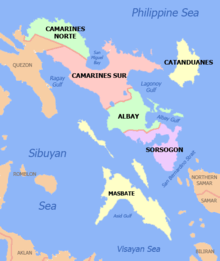Daet, Camarines Norte
Daet (IPA: [daʔet]), officially the Municipality of Daet (Tagalog: Bayan ng Daet), is a 1st class municipality and capital of the province of Camarines Norte, Philippines. According to the 2015 census, it has a population of 104,799 people.[3]
Daet | |
|---|---|
| Municipality of Daet | |
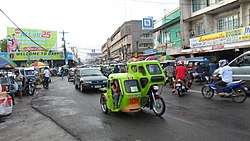 Daet Downtown Area | |
 Seal | |
| Nickname(s): Gateway to Bicolandia | |
| Motto(s): Bayan tungo sa Kaunlaran! | |
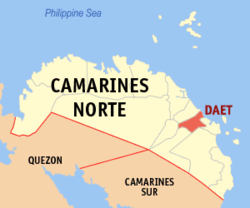 Map of Camarines Norte with Daet highlighted | |
OpenStreetMap 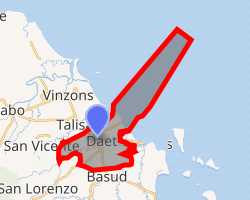
| |
.svg.png) Daet Location within the Philippines | |
| Coordinates: 14°07′N 122°57′E | |
| Country | |
| Region | Bicol Region (Region V) |
| Province | Camarines Norte |
| District | 2nd district |
| Founded | 1583 |
| Barangays | 25 (see Barangays) |
| Government | |
| • Type | Sangguniang Bayan |
| • Mayor | Benito S. Ochoa |
| • Vice Mayor | Rosa Mia L. King |
| • Congressman | Marisol C. Panotes |
| • Electorate | 57,231 voters (2019) |
| Area | |
| • Total | 46.00 km2 (17.76 sq mi) |
| Population (2015 census)[3] | |
| • Total | 104,799 |
| • Density | 2,300/km2 (5,900/sq mi) |
| • Households | 22,803 |
| Economy | |
| • Income class | 1st municipal income class |
| • Poverty incidence | 21.35% (2015)[4] |
| • Revenue (₱) | 247,899,439.82 (2016) |
| Time zone | UTC+8 (PST) |
| ZIP code | 4600 |
| PSGC | |
| IDD : area code | +63 (0)54 |
| Climate type | tropical rainforest climate |
| Native languages | Central Bikol Tagalog |
| Website | daet |
The municipality is a popular surfing spot among surfers worldwide. It is also home to the annual Daet International Aerosports Show, first held in 2013.
Etymology
The name Daet was derived from the Bikol word dai-daitan which means, close to each other. Daet also originated from ancient Bicol term daet which, according to the first Bicol Spanish Dictionary Vocabulario de la Lengua Bicol authored by Fray Marcos de Lisboa, would mean "to make friend" or "to be reconciled".
History
Pre Colonial
Daet was already an old community even before the discovery of the Philippines by Magellan in 1521. An ancient tomb unearthed in the Bicol region revealed references described in the Panayam manuscripts known to oriental history as corresponding to the first half of the thirteenth century. The early settlers were believed to be direct descendants of the group of datus who escaped from the court of Brunei (Borneo) to evade the enmity of a ruling rajah .
Spanish Colonial Era
In 1571, Juan de Salcedo arrived at the Bicol Region in quest for gold found in Camarines Norte and discovered that Daet was already a thriving settlement and noted that the houses were clustered together for reason of safety and protection. In June 1583, through a Franciscan Order confirmed the founding of Doctrinas including Daet.
Long after the implantation of the Spanish sovereignty, Don Juan de Salcedo, “talented, dashing grandson of Legazpi ” found this community in the course of an expedition in search of gold which the Camarines mountains were heart to abound, marking the beginning of over a three-century Spanish regime patterned after the sword and the cross.
In the meantime, an incident happened in the court of Spain over the romances of a woman which pressed the King to exile a Spanish noble to the Philippines who eventually chose to come this way to spend the rest of his life, forget all, and start life anew. This noble was Don Manuel de la Estrada, Marquis de Camarines , who devoted a lifetime to help implement the Spanish colonization blueprint in the building of a new town over our old community. He supervised the construction of the church as it stands today, the old Spanish to exile a Spanish noble to the Philippines who eventually bridge (now covered by a Bailey bridge ), other stone bridges buildings. He also brought the first abaca seedlings and encouraged its cultivation which has given the Philippines the world monopoly of hemp fiber. Incidentally, from the union of this noble to a Filipino woman followed a long line of blood relation which still link most of the old families of this community. The ruins of the palatial mansion of the Marquis de Camarines were still visible in recent years, on the spot where the new building of the Provincial Capitol now stands.
Except for recurring raids by the Moro pirates who occasionally came on their fast frail vintas to pillage this community causing the fortification of barrio Mercedes (now an independent municipality since 1948) during the Spanish regime, this community lived progressively in blissful peace and contentment. Formerly, the whole of the present Province of Camarines Norte was known as the District of Daet and this capital was a “Comandancia” of the original province of Camarines during the Spanish regime. In the few times that the Province of Camarines Norte was separated from and again fused with Camarines Sur from the Spanish to the American regimes, Daet always retained her importance as the provincial capital. In the ensuing changes, this municipality lost further much of her territory which was restored to Camarines Sur, and due to the segregation of the Municipality of Basud which was a former barrio of this community in the year 1908.
No less than thirteen martyrs were contributed by this community before the altar of liberty. They were butchered or burned alive and buried in a common grave during the Holy Week on Easter Sunday, April 1898. The local “insurrectus ”, however, made a remarkable feat in the last days of the Spanish regime when they succeeded in containing the Spanish local garrison and subjected them under relentless attack. The Spaniards were dramatically saved from annihilation by burning at the timely arrival of their rescue ship. Daet today takes a distinct pride for owning the first monument ever erected in the Philippines in honor of the foremost Filipino hero and martyr, Dr. Jose P. Rizal Protacio y Mercado , at the inspiration of Don Antonio Sans, Commanding Officer of the Philippine Revolutionary Forces in the sector.
American Colonial Period
The Philippine–American War was felt very little in this town. The American forces came unopposed on March 4, 1900 when almost the rest of the Bicol Region was subdued by Major McNamee under the overall command of General Bates before whom Commander Antonio Sans previously arranged in Camarines Sur the terms of surrender which were acceptable to the American Command. The strides undergone by this community under the American regime is yet to be written in bold letters of gold, a period which brought about the present day progress of this generation.
Martial law
On the evening of September 23, 1972, President Ferdinand Marcos announced on television that he had placed the Philippienes, including Daet, under martial law.[5] The marked the beginning of a 14-year period of one-man rule;[6][5] even though the document proclaiming Martial Law was formally lifted on January 17, 1981, Marcos retained essentially all of his powers as dictator until he was deposed by the February 1986 People Power revolution.[6][7][8]
On June 14, 1982 Marcos administration forces opened fire on protesters from different barrios, who were marching to demand an increase in copra prices, and to denounce "fake elections" and Cocofed. Four people died on the spot, and at least 50 were injured. Two of those who were seriously wounded died two months later.[9] This has come to be known as the "1981 Daet massacre," and four of those killed have since been honored by having their names engraved on the Wall of Remembrance at the Bantayog ng mga Bayani memorial.[10]
Conversion to cityhood
A P30-million government center, a P30-million transport terminal and an improved airport are among the large-scale face-lift projects that Camarines Norte's capital town plans to embark on as it aggressively vies for cityhood.
The projects, including a new face of the town plaza, were presented by Mayor Tito Sarion in an executive report last month. "The enhancement of the elevated plaza is necessary to decongest the downtown in an attempt to rebuild the center of the commercial district," he said.
Sarion said the United Architects of the Philippines had agreed to design the new plaza through a P3-million grant provided by the party-list group Bayan Muna.
The funds for the government center and transport facility will be borrowed from the Land Bank of the Philippines, while the revitalized Bagasbas airport project will be funded by the Air Transportation Office (ATO).
Sarion said the proposed government center would make transactions with provincial and national government agencies more convenient while the new legislative hall would "create a breathing space and a better working environment at the municipal hall, where offices are crowded."
Geography
Barangays
Daet is politically subdivided into 25 barangays.
- Alawihao
- Awitan
- Bagasbas
- Barangay I (Ilaod)
- Brgy II (Pasig)
- Brgy III (Iraya)
- Brgy IV (Mantagbac)
- Brgy V (Pandan)
- Brgy VI (Centro)
- Brgy VII (Diego Liñan)
- Brgy VIII (Salcedo)
- Bibirao
- Borabod
- Calasgasan
- Camambugan
- Cobangbang
- Dogongan
- Gahonon
- Gubat (3 Districts – Moreno, Gubat, & Mandulongan)
- Lag-on
- Magang
- Mambalite
- Pamorangon
- Mancruz
- San Isidro
Climate
| Climate data for Daet, Camarines Norte (1981–2012, extremes 1920–2012) | |||||||||||||
|---|---|---|---|---|---|---|---|---|---|---|---|---|---|
| Month | Jan | Feb | Mar | Apr | May | Jun | Jul | Aug | Sep | Oct | Nov | Dec | Year |
| Record high °C (°F) | 32.8 (91.0) |
34.3 (93.7) |
34.9 (94.8) |
36.0 (96.8) |
37.2 (99.0) |
37.0 (98.6) |
36.0 (96.8) |
36.7 (98.1) |
36.1 (97.0) |
35.4 (95.7) |
35.6 (96.1) |
36.0 (96.8) |
37.2 (99.0) |
| Average high °C (°F) | 28.6 (83.5) |
29.1 (84.4) |
30.1 (86.2) |
31.6 (88.9) |
32.8 (91.0) |
32.8 (91.0) |
32.0 (89.6) |
32.2 (90.0) |
31.8 (89.2) |
30.8 (87.4) |
30.1 (86.2) |
28.8 (83.8) |
30.9 (87.6) |
| Daily mean °C (°F) | 26.0 (78.8) |
26.2 (79.2) |
27.0 (80.6) |
28.3 (82.9) |
29.0 (84.2) |
28.9 (84.0) |
28.4 (83.1) |
28.6 (83.5) |
28.1 (82.6) |
27.6 (81.7) |
27.3 (81.1) |
26.4 (79.5) |
27.7 (81.9) |
| Average low °C (°F) | 23.5 (74.3) |
23.3 (73.9) |
23.9 (75.0) |
24.9 (76.8) |
25.2 (77.4) |
25.1 (77.2) |
24.8 (76.6) |
24.9 (76.8) |
24.5 (76.1) |
24.4 (75.9) |
24.6 (76.3) |
24.0 (75.2) |
24.4 (75.9) |
| Record low °C (°F) | 17.1 (62.8) |
15.1 (59.2) |
17.3 (63.1) |
16.3 (61.3) |
19.8 (67.6) |
20.6 (69.1) |
20.8 (69.4) |
20.0 (68.0) |
16.3 (61.3) |
18.2 (64.8) |
17.8 (64.0) |
15.8 (60.4) |
15.1 (59.2) |
| Average rainfall mm (inches) | 266.3 (10.48) |
180.1 (7.09) |
150.4 (5.92) |
131.3 (5.17) |
138.5 (5.45) |
183.9 (7.24) |
237.1 (9.33) |
165.4 (6.51) |
257.9 (10.15) |
496.3 (19.54) |
542.9 (21.37) |
588.4 (23.17) |
3,338.4 (131.43) |
| Average rainy days (≥ 0.1 mm) | 22 | 15 | 13 | 10 | 12 | 14 | 16 | 15 | 17 | 23 | 25 | 25 | 207 |
| Average relative humidity (%) | 87 | 86 | 86 | 85 | 85 | 85 | 87 | 86 | 88 | 88 | 88 | 88 | 87 |
| Source: PAGASA[11][12] | |||||||||||||
Demographics
|
| |||||||||||||||||||||||||||||||||||||||||||||
| Source: Philippine Statistics Authority[3][13][14][15] | ||||||||||||||||||||||||||||||||||||||||||||||
In the 2015 census, the population of Daet, Camarines Norte, was 104,799 people,[3] with a density of 2,300 inhabitants per square kilometre or 6,000 inhabitants per square mile.
Economy
The municipality is rich in mineral resources such as diatomaceous earth (DE) or commonly called white clay. This is one of the income generating industries of the municipality. This non-metallic mineral has a total approximate reserve of 1,289,600 metric tons.
The municipality also has a viable source of sand and gravel. It is being extracted by mining concessionaires.
Infrastructure
Land transportation is the primary means of transporting people, goods and services from the barangay to the town proper of Daet. The town is being linked to its different barangays by the municipality's major roads, namely the Maharlika Highway. It has a total length of 25.50 kilometers stretching from the boundary of the municipality of Daet to the Camarines Norte – Camarines Sur boundary. The Mangcamagong provincial road has a total length of 9.46 kilometers, stretching from the municipal boundary of Basud and Mercedes to the junction of Maharlika highway.
- Water supply: The barangays of the municipality is being served by levels I, II and III water supply. To cope with the consumption demand especially during summer, the CNWD has constructed an elevated water tank with a capacity of 200 cubic meters and implementing the "Tubig ng Buhay, Hatid sa Barangay" program. Some barangays are being served by shallow wells, deep wells or dug wells.
- Power supply: Daet is being served by electric power, formerly by the defunct Hidalgo Electric Enterprise, now by the National Power Corporation through the Camarines Norte Electric Cooperative (CANORECO). After the establishment of this cooperative, there was a great improvement in terms of power supply condition in the municipality.
- Communication: Daet has a telecommunication system that is being run by one personnel of the Department of Transportation and Communication (DOTC). There are three satellites of Smart, Globe and Sun Cellular. There is postal office and has a staff of one mail carriers serving all barangays in the municipality. These personnel cannot adequately serve the entire from the lack of personnel; another problem is the difficulty in the delivery of mails in the remote and far-flung barangays.
Tourism and attractions
Surfing and beaches
Daet is a famous surfing and kiteboarding spot, as it has a long stretch of beach in Bagasbas. Because of the attention it has gotten from the local surfing community, the Philippine Department of Tourism turned it into a local accredited surfing spot.
Aside from being a spot for surfing and kiteboarding, the Calaguas group of islands, in the jurisdiction of Vinzons, to its north has garnered attention from local and foreign tourists alike. The islands can be considered virgin since no resorts have been created there yet.
Places of interest
- University of Camarines Norte
- Ninoy and Cory Aquino Boulevard, the longest boulevard in the Philippines.
- SM City Daet (located in Lag-on)
Churches
- Most Holy Trinity Cathedral, it was built and was inaugurated in 1984. It is also the cathedral of the Diocese of Daet
- Parroquia de San Juan Bautista, established in 1611, it is one of the first church in Camarines Norte in the region built by the Franciscan Friars.
- Saint Joseph, Husband Of Mary Parish in Lag-on
- Our Lady Of Peñafrancia Parish in Moreno Dist., Gubat
- Divine Mercy Parish in Alawihao
Historical landmarks
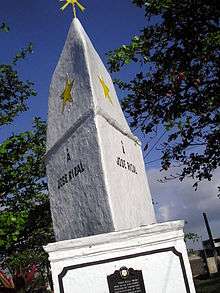
- 1st Rizal Monument - The first monument in honor of a Filipino hero, Dr. José Rizal. Its foundation was made of mortars and boulders from the demolished old Spanish jail in Daet. Lt. Col. Antonio Sanz and Lt. Col. Ildefonso Alegre of Philippine Revolutionary Army initiated the construction of the monument which was unveiled on December 20, 1898.
- Provincial Capitol
- Old Daet Municipal Building
- Daet Elevated Town Plaza
- Daet Municipal Building
- Pineapple Fountain
- President Cory Aquino Boulevard (Bagasbas Boulevard)
Festivals
The Pineapple Festival (or "Pinyasan" as it is called by the locals) is considered to be the most colorful festivals in Camarines Norte. The festival started in 1992, and is about the province's prime agricultural product, which is the "Queen of All Pineapple" pineapple. Noted for its sweetness and flavor, this kind of pineapple is produced only in Camarines Norte, thereby making it a specialty in the province. The festival goes on for about 10 days, and several events are held in the municipality. The festival aims to promote the culture of Daet and its citizens. The Pineapple Festival is held every 22–26 June annually initiated by Mayor Tito Sarte Sarion
The Bantayog Festival celebrates the founding of Camarines Norte. As of 2009, it has been 89 years since the province has become independent, since March 3, 1975, when Ambos Camarines (At that time Camarines Norte and Camarines Sur were one province) was split from two. This festival promotes the province as one which has unnoticed potential in the fields of tourism and commerce, and also the rich culture and hospitality of the people of Camarines Norte. The Bantayog Festival is held every March or April annually. It was launched in April 1982.
Notable people
- Ambet Nabus, Radio Anchor and Show Business Reporter
- Manuel Conde, Multi awarded Actor/Director, National Artist for Cinema (2009)
- Robin Padilla, Actor
- Fortunato "Atoy" Co, Former PBA Player, Actor, Politician
- Ricky Lee, Scriptwriter
- Joross Gamboa, TV Actor
- Liwayway Vinzons-Chato, Former BIR Commissioner, Politician
References
- "Municipality". Quezon City, Philippines: Department of the Interior and Local Government. Retrieved 31 May 2013.
- "Province: Camarines Norte". PSGC Interactive. Quezon City, Philippines: Philippine Statistics Authority. Retrieved 12 November 2016.
- Census of Population (2015). "Region V (Bicol Region)". Total Population by Province, City, Municipality and Barangay. PSA. Retrieved 20 June 2016.
- "PSA releases the 2015 Municipal and City Level Poverty Estimates". Quezon City, Philippines. Retrieved 1 January 2020.
- "The Fall of the Dictatorship". Official Gazette of the Republic of the Philippines. Archived from the original on 2017-09-03. Retrieved 2018-09-09.
- Francisco, Katerina (2016-09-22). "Martial Law, the dark chapter in Philippine history". Rappler. Archived from the original on 2016-09-23. Retrieved 2018-06-29.
- Tan, Ab (1981-01-18). "Marcos Ends Martial Law, Keeps Tight Grip". Washington Post. ISSN 0190-8286. Retrieved 2018-09-09.
- "Back to the Past: A timeline of press freedom". CMFR. Sep 1, 2007. Retrieved March 2, 2018.
- Doyo, Ma. Ceres P. "Martial law massacres". Philippine Daily Inquirer. Retrieved 2018-06-18.
- "Martyrs of the 1981 Daet Massacre". Bantayog ng mga Bayani. Retrieved 2020-04-10.
- "Daet, Camarines Norte Climatological Normal Values". Philippine Atmospheric, Geophysical and Astronomical Services Administration. Archived from the original on 13 October 2018. Retrieved 13 October 2018.
- "Daet, Camarines Norte Climatological Extremes". Philippine Atmospheric, Geophysical and Astronomical Services Administration. Archived from the original on 13 October 2018. Retrieved 13 October 2018.
- Census of Population and Housing (2010). "Region V (Bicol Region)". Total Population by Province, City, Municipality and Barangay. NSO. Retrieved 29 June 2016.
- Censuses of Population (1903–2007). "Region V (Bicol Region)". Table 1. Population Enumerated in Various Censuses by Province/Highly Urbanized City: 1903 to 2007. NSO.
- "Province of Camarines Norte". Municipality Population Data. Local Water Utilities Administration Research Division. Retrieved 17 December 2016.
External links
| Wikimedia Commons has media related to Daet, Camarines Norte. |
